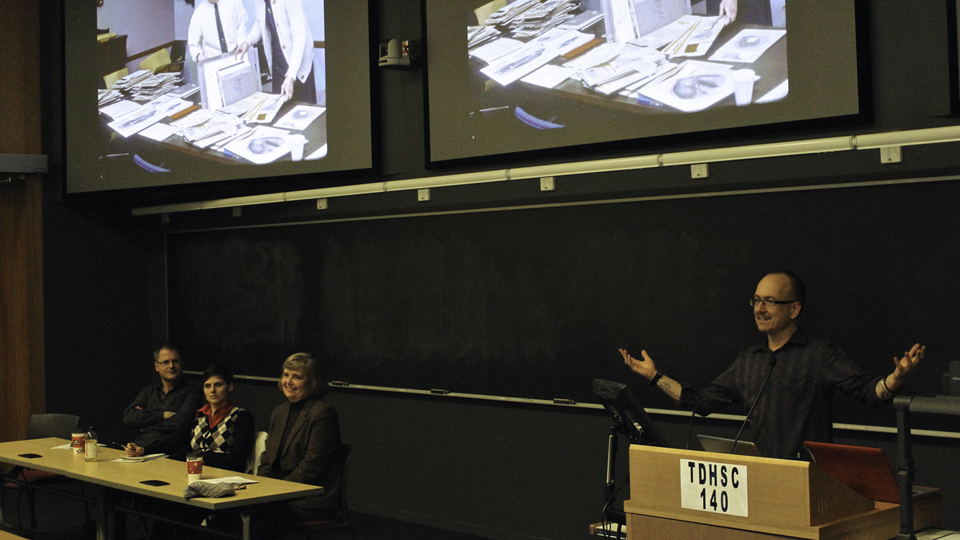Braving the rain and gusting winds, students, faculty, and members of the community made the trek to UTM’s Terrence Donnelly Health Sciences Complex last Monday for a presentation called “Illuminating the Body: Grant’s Atlas”.
The roundtable discussion came in conjunction with the Blackwood Gallery’s new exhibition, “Splice: At the Intersection of Art and Medicine”. But while “Splice” focusses on many different approaches to presenting anatomy in art, this presentation focussed on one: the famed Canadian publication Grant’s Atlas of Anatomy.
While Grant’s Atlas is primarily an educational text for students and professionals studying medical sciences, there is plenty of artistry in the lifelike illustrations of the human anatomy in its pages. And “Illuminating the Body” offered a fascinating look into how Grant’s Atlas has changed with the times—and how it’s stayed the same.
Grant’s Atlas was first published in 1943 under the editorship of John Charles Boileau Grant, who at the time served as the chair of anatomy at U of T. As the speakers in Monday night’s presentation explained, his atlas was groundbreaking in its time. Before it appeared, most anatomy guides were produced in Germany, and they took a broader look at the human body. Whereas those books focussed on anatomy from a systemic perspective, Grant and his illustrators took a much more “regional” approach. Their detailed, micro-level depictions of human anatomy have since become the accepted standard in such atlases, and many other anatomy guides to come out since have followed Grant’s example.
Three speakers took part in Monday’s discussion, and each brought a unique perspective to the subject. Professor Ann Agur, who works at U of T’s faculty of medicine in the anatomy division and is the current editor of Grant’s Atlas, provided an extensive background on the history of the atlas and its ties to U of T. She also described the “amazing” feeling of being appointed the editor of Grant’s in the early 1990s, despite not having a PhD and being one of the few female anatomists of the time.
“Some of the very, very senior and well-known anatomists were… not so nice,” she said of her early days as editor.
Dave Mazierski, an associate professor of biomedical communications at UTM, described Grant’s as “the supreme anatomy atlas for over 30 years after the war”, but said that in the 1980s it had had difficulties keeping up with the sales of newer atlases that published colour illustrations. This was the point when Mazierski stepped in and helped colourize the original black and white Grant’s illustrations. In his presentation, he described how difficult the process was (since digital alteration was then too costly) and the time-consuming work that went into hand-colouring photographs of the original drawings.
Drew Danielle Belskey, a graduate student at York whose artwork is currently on display in “Splice”, provided some background on the field of biomedical communications (which is essentially the study of medical illustration), and also addressed the intersection of art and science. Recalling her own past of looking into the archives of U of T’s biomedical communications department, she acknowledged how much the line drawings of anatomy that she saw inspired her own work. Belskey also spoke about the balance of the metaphorical and the literal in her artwork—a common challenge in combining the seemingly disparate worlds of art and science.
For those uninitiated in the world of biomedical communications, “Illuminating the Body” provided something of a crash course in the field and highlighted the artistry involved in it. It was a fascinating and accessible look at an influential Canadian publication, and it also provided the opportunity for those involved in its creation to shed light on their experiences. Several students in the biomedical communications graduate program (which is taught in the Health Sciences Complex) were present at the roundtable discussion. Perhaps years from now, one of them will be leading a similar panel about future incarnations of Grant’s Atlas.

